Moving Plants Out of Harm’s Way Before Construction Starts
A year ago last March, I learned that renovations were planned for our home. The kitchen was going to be bumped out onto the deck, so that it was even with the screened porch. The screened porch was going to be upgraded to a three-season room. And the deck surrounding it all was going to be pushed out into the garden beds I referred to as the Deck Alcove Bed and Deck West Bed. And when was this going to happen?
June.
June! I thought about all the plants in that garden–and I also thought about how construction projects never start when they say they’re going to start–and I came up with three principles to guide me through the upheaval.
1) Be Philosophical
You will lose plants, no matter how hard you try to save them all. But hey, some plants die every year, anyway. If you don’t try to save any of them, it’s guaranteed they will all die. If you can save some, you’re that much ahead of the game. Furthermore, every plant that dies is an opportunity to try a new plant, and this renovation project is an opportunity to design a new garden.
2) Be Strategic
Or should I say, practice triage? Some people would avert their eyes during construction, and assess the damage from workers’ feet and equipment when it was all over. But I am not one of those people. So: what reasons are there for rescuing plants, and which reason is the most important? And where are you going to put them? I’ll discuss where to put them in a little bit, but here are my criteria for saving plants.
- It’s hard to replace–rare in commerce
- Someone gave it to me or special provenance (eg. I grew it from seed/cuttings)
- It would be expensive to replace, especially at its current size/maturity
- I just love it!
But also realize that while you are saving plants, you are spending time. If you’re rescuing plants to save money, how much is your time worth? What will you not be doing, because you’re digging up plants instead?
3) Be Flexible
Roll with the punches. Think outside the box. Don’t worry, be happy. All those clichés have a kernel of truth. Having developed a plan for what to save first, there will be obstacles and interruptions to that plan. Try to not freak out about this.
Where were the plants going?
I commandeered about a third of the vegetable garden my husband had abandoned for health reasons. He had spent a good deal of effort amending the soil and removing rocks, so all I had to do was remove the weeds. You know, eight-foot-tall stoloniferous goldenrod and three-foot-tall deep-rooted dock. Once weeded, that would be a good place for sun-loving plants to grow while waiting for their new digs.
As I strolled around the house I realized there were areas where the riding lawn mower couldn’t go. Turning these areas into garden beds would be the least intrusive way of removing lawn. Happily, these areas were in shade.
One area was just an extension of the bed on the north side of the house. The other area surrounded our large propane tank and connected it to a little grove of trees I’ve dubbed the Bird Sanctuary.
I decided to record where I moved the plants in a small spiral notebook. Except sometimes I forgot to.
So What Actually Happened?
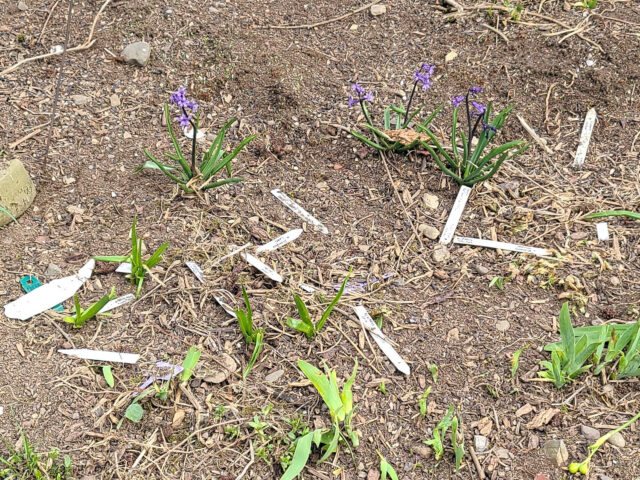
The ten-year-old chicken fence had developed several holes. The chickens, starved for greens and bugs after a snow-covered winter, happily left the confines of their yard to scratch in my garden beds. Any hope I had of keeping my daffodil varieties correctly identified was dashed. Not a great start to the Great Migration.
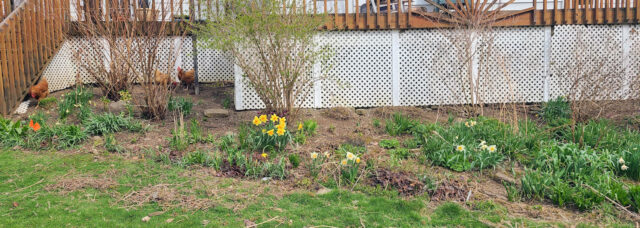
The first week of May
The first week of May, I took pictures of the Deck Alcove and Deck West so I would be able to locate the daffodils when their foliage had died and it was the best time to dig them. Sadly, I forgot I had taken those pictures when it came time to dig.
But it wouldn’t have helped too much because in the photos some daffodils had already bloomed, and some had yet to bloom. The best strategy would have been to dig and move them while they were blooming (it can be done, you just have to baby them a bit), but–the goldenrod and dock had to go first.
Yes, I was in the awkward position of needing to move plants to beds that weren’t yet ready for them. So I alternated between moving plants to already established beds–where I could find spots for them–and getting new beds ready.
I also started potting up plants to give away. As anyone who has transplanted a perennial has discovered, when you dig a plant up there is always more of it than you expected, so you keep a nice chunk of it for yourself and give some to your friends or donate the leftovers to a plant sale.
The first day of June
The first day of June, my son Arlan spent the day helping me. I gave him all the hard jobs that I had been dreading: digging up the monster hostas, the thorny moss rose, the woody-rooted peonies. Yes, you’re not supposed to dig peonies in the spring, but since I felt construction work was to commence any day now, I moved them while I had the chance.
We also started in on the goldenrod and dock. I’ve chronicled my previous encounters with both of those weeds, so I won’t go into the gory details here, except to say that the clay soil was at that perfect level of moisture where roots come out easily without much soil sticking to them. It was a godsend.
The New Shade Beds
Designing a new bed is one of the most creative aspects of gardening. Even though I felt under pressure, I enjoyed the process. I decided the North Bed Extension would be green and white.
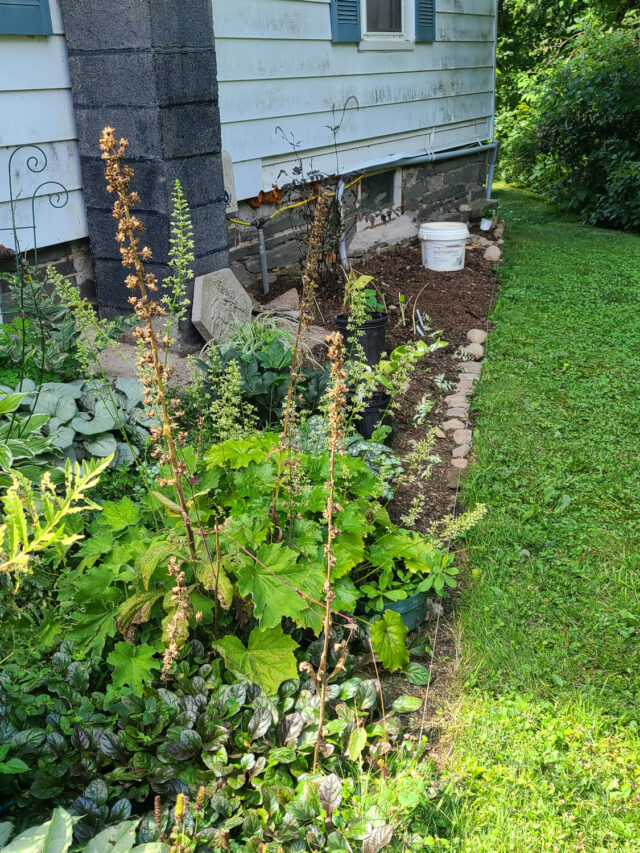
I planted the Propane Bed primarily with foliage: golden, purple, and glaucous blue.

The Nursery Bed
As June went on I continued to remove goldenrod and dock from the Nursery Bed, and move plants there as space became available, following my triage rules since construction was to start any day now. Any day! Except it didn’t. One postponement led to another, and I was still planting into November.
Yes, dear reader, construction never started in 2022. It started this year, in April. So I dug, and relocated, a lot of plants. Pretty much everything I had even the slightest desire to save.
To get the job done, I neglected the rest of the garden. Scant pruning, no edging, and only the most egregious, bodacious, I-can’t-stand-it-any-longer weeds were pulled. I did water relocated plants during dry spells.
This Year
At the beginning of this year, the shrubs–which abutted the current deck and would be in the way of the expanded deck–had not yet been moved. They had been pruned back last year, and the Abelia monsanensis had even been root-pruned. My son Evan had dug holes for them in the Nursery Bed, but they never got moved that fall. Evan dug the imperiled shrubs and moved them just days before work was to start. They were still dormant when moved, and I’m happy to report they leafed out and bloomed normally.
Having trashed the rest of my garden last year in order to save the plants doomed to destruction, I thought this year would be exclusively devoted to bringing the rest of my garden back under the illusion of control. But, no.
Rescue Obsession
For as winter turned to spring, the plants that I had missed emerged, and I went on another round of plant rescue. Many were daffodils and other spring bulbs. After I dug and relocated (or gave away) all of those, there was a lull–which coincided with a dry spell. I edged a couple of beds since I didn’t want to plant anything in the dry soil and weeding was difficult.
Then more plants emerged. By now the new deck had been built but the lattice screening had not been installed. I had to hunch over as I dug a lot of Jacks-in-the-pulpit, some astilboides, catmint, shrub suckers, and other plants. And yes, I whacked my head a few times.

As long as there were garden-worthy plants growing under the deck, I felt compelled to dig them. Why? I don’t know. Finally the lattice was installed around the deck, putting an end to my digging. Or did it?
Shortly after the deck was sealed up, I learned the propane tank was to be upgraded to a larger one. You know, the propane tank I just created a shade bed around. That propane tank.
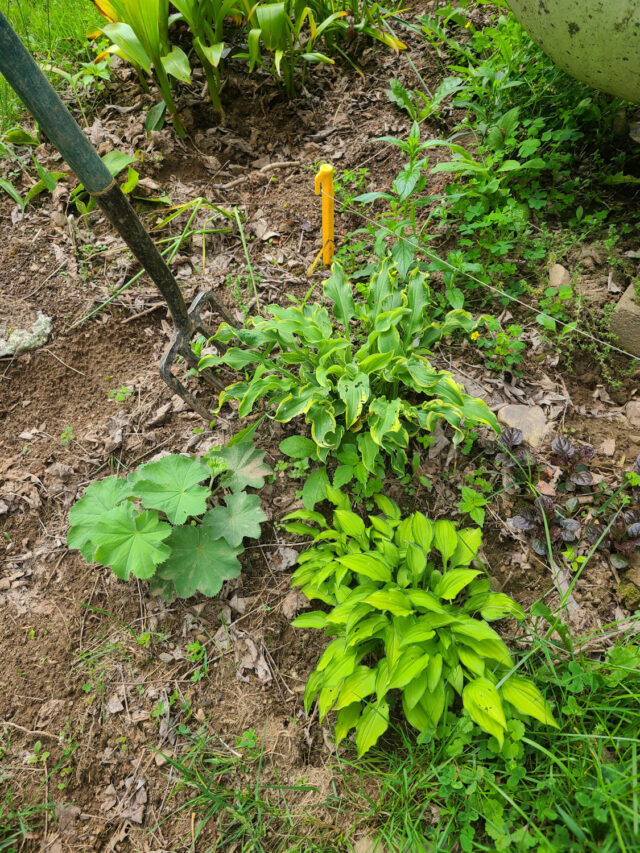
I’m currently in the midst of replanting that area, after potting up the plants surrounding the tank. I took a day off from that job to putter in the rest of the garden. No big projects, just little things that were bugging me. For once it felt like normal gardening instead of a rescue operation.
Last year I imagined that as plants came into bloom in the Nursery Bed, I would decide where their new home was and relocate them. Plants are coming into bloom, all right, but the new home isn’t ready. It isn’t even “built” yet. I hope by fall I will have places prepared for the shrubs, at least.
The adventure isn’t over yet, and I can see it’s going to go on for at least another year. What big projects have you tackled, and how long did they last?
Before
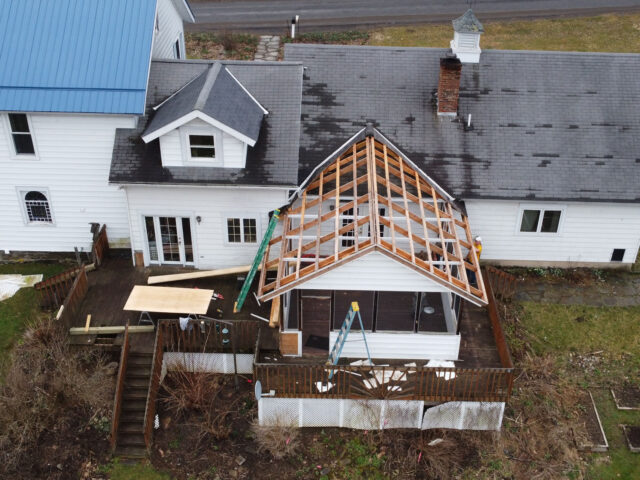
The Plan
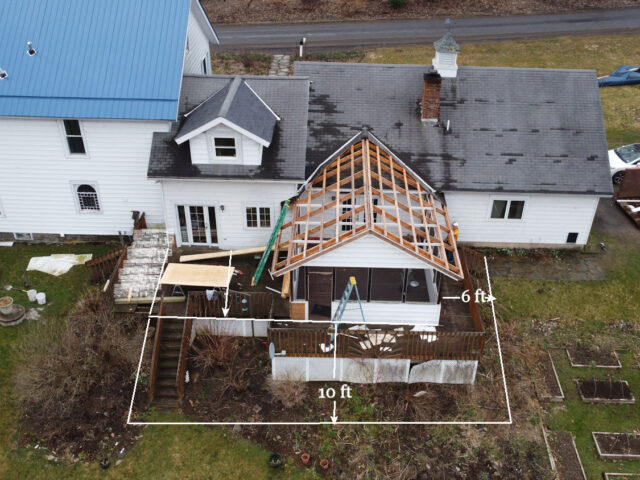
After





Oh my gosh I’m exhausted from reading all that. It’s like a massive shell game where you’re running around picking out the biggest challenges and then all the challenges change.
I like to remind myself there was nothing here when we moved in, and it’s so nice to work with a clean slate…. but then I miss stuff, so it’s always better to give stuff away to friends, just in case!
You are so sanguine about all these upheavals. I love your gently humorous approach to the whole thing – at least as you present it to us! I hope you soon enjoy the improvements inside and the fun of creating more beds outside.
If you’ve been gardening for decades–as I have–you lose enough plants to natural causes that eventually you come to realize that there are always changes and upheavals in the garden. The thing that made me most anxious was the shrubs. But not because I was that afraid of losing them, but because I was afraid they would still be in the way of the contractor when it was time to build the new deck. That didn’t happen, so we’re all good.
Oh I know this work well. We redid a basement and screen porch. A much smaller project that started in deep winter but still the south side gardens and the back hill garden were trampled, stuff from gutting the basement kept showing up the following summer. Those two beds were completely redone. Hang in there it will be finished some day!
Thank you for the encouragement, Joanne!
Your project makes my current garden disturbance a piece of cake. I moved Peonies mid-summer and turned my moss garden into holding beds for plants moved when we put in a new driveway and stone wall in 2015. It helps to be prepared and then stand back. I’m letting plants cover the paths so I can dig them out and fill in the damaged areas come fall. You are right that it’s a great opportunity to redo areas. Terrific column.
Thank you, Linda. I’m glad you enjoyed it.